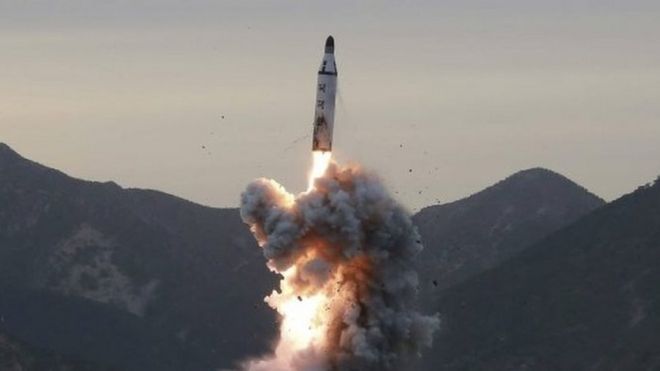 EPA
EPANorth Korea displayed a lot of missiles - including big ones - at a bombastic military parade over the weekend. But what do we really know about Pyongyang's missile capabilities? Defence expert Melissa Hanham explains.
Kim Jong-un put on quite a show to mark the 105th anniversary of the birth of his grandfather Kim Il-sung, North Korea's founding leader. More new hardware was on display than ever before, including new inter-continental ballistic missiles (ICBMs).
To its domestic audience, it was a demonstration of technological might and prosperity. To outsiders it was a threat: be you near or far you will eventually be in range.
The Kim Jong-un years have seen increasingly frequent missile tests, all defying UN sanctions, but have they made any difference to the North's capabilities?
 REUTERS
REUTERSThe birth of North Korea's missile programme
North Korea's ballistic missile programme grew out of one of the most widely proliferated missiles of all time: the Scud.
In 1979, then Egyptian President Anwar Sadat transferred a small number of the Soviet missiles to North Korea as part of a broader agreement to co-operate on missile technology.
North Korea then reverse-engineered the Scud and began producing and testing their own missiles, called Hwasong-6 and Hwasong-7.
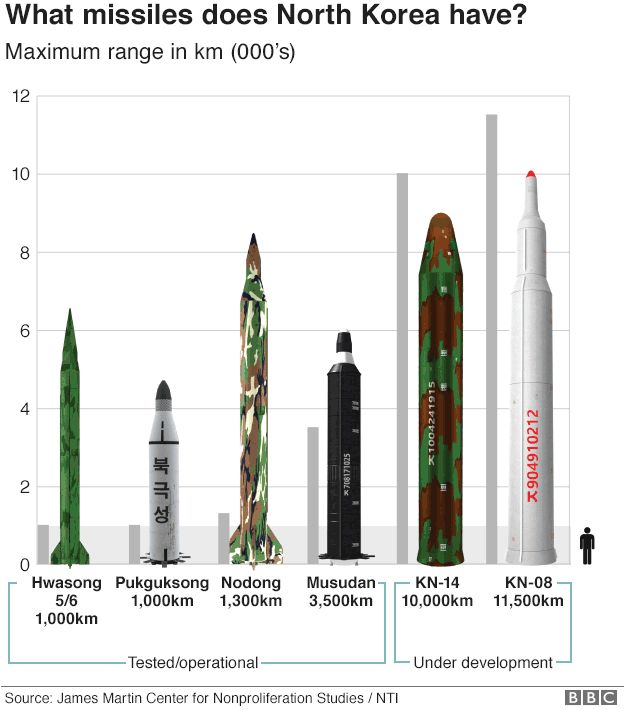
In time, they extended the range of the Scud and elongated the body to create a missile called the Nodong.
Eventually, North Korea began clustering those Nodong engines to create a staged space launch vehicle called the Unha-3, a rocket capable of carrying a payload outside the earth's atmosphere.
While the Scud family of missiles is not advanced, the missiles are reliable and relatively cheap to produce. The Nodong is nuclear-capable, and North Korea even exported it to Pakistan and Iran.
- But there were other advances to be made.
- North Korea's missile programme
- North Korea threatens new missile tests
- How advanced is North Korea's nuclear programme?
- Making missiles that can easily be hidden
More recently, North Korea reverse-engineered the Soviet R-27 submarine-launched ballistic missile (SLBM) into a road-mobile missile that could hit US forces in Guam.
The missile, known as the Musudan, was displayed on military parades for years, but North Korea only started testing it in 2016.
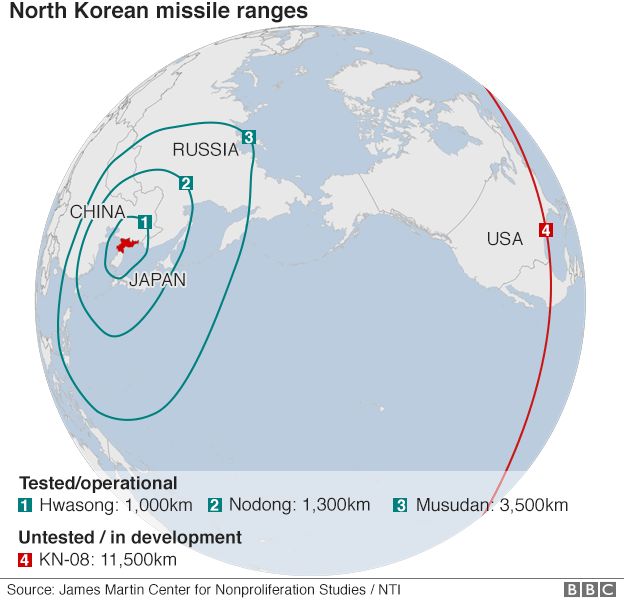
After six Musudan tests, there has only been one notable success, in June 2016.
But the incremental changes between each test are interesting to note. For example, after one of the failures damaged the transporter erector launcher (TEL) truck badly, North Korea sent out the next TEL with shielding over its wheels and chassis.
And, yes, this missile is probably nuclear-capable.
Nearly all of North Korea's missiles are road mobile. This means North Korea can keep the missiles continuously moving around the country on TELs. These trucks can be hidden in tunnels, warehouses, bunkers and caves. Constantly moving them and hiding them makes them harder to detect.
Missiles that can be launched from water
2016 was also an important year for submarine-launched ballistic missiles. After disastrous failures in 2015, North Korea began to make some progress on a missile known as the Pukguksong.
 AFP
AFPUsing an underwater platform, North Korean engineers were previously able to achieve successful ejection of the missile but could not get the stage to light or achieve much range. After a test of a solid- (rather than liquid-) fuelled engine in April 2016, North Korea began to have increasingly successful SLBM tests.
These SLBMs are not nearly as worrying as the SLBMs that the US, Russia or China possess. They will remain unreliable unless testing continues. North Korea's submarines are also loud and easy to detect. So in many ways these missiles are more for domestic "prestige" than military use.
That being said, satellite imagery shows that North Korea is investing a lot in overhauling the submarine shipyard at Sinpo. So this is just the beginning of its programme.
The KN-17 (a label assigned by the US) shown in the most recent parade is also being tested near Sinpo. This land-based anti-ship ballistic missile has had two failures so far, but its message is that US, South Korean and Japanese ships should beware.
Missiles that use solid fuel
In February 2017, North Korea tested a land-based version of its solid-fuelled SLBM, called the Pukguksong-2, launching it from a canister on the back of a TEL.
North Korea traditionally relied on the same liquid fuel that Scuds used. This fuel is reliable and cheap, but it is corrosive and cannot be stored in the missile. This means that missile convoys have to travel with fuel and oxidizer trucks, making them larger and easier to spot from satellites. It also means the missile cannot be moved or stored while fuelled, so the launch process takes longer.
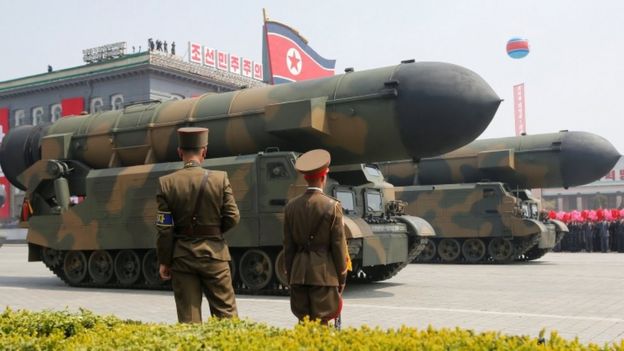 REUTERS
REUTERSA truck will pull out of a tunnel, for example, erect the missile, the unit will fuel it and target it, and then launch.
However, solid fuel can generally be stored in the missile, shaving valuable time off a launch in a war scenario.
The parade showed that North Korea is committed to solid fuel by showing off two new possible solid fuel ICBMs in canisters.
The canisters may have been empty (why load a missile if nobody's going to see it?), but it's likely that this is a design concept that will evolve over several parades and component tests.
Developments since the start of 2016 have shown that North Korea is focusing not just on new missile technologies, but also on the actual deployment of the missile in the field.
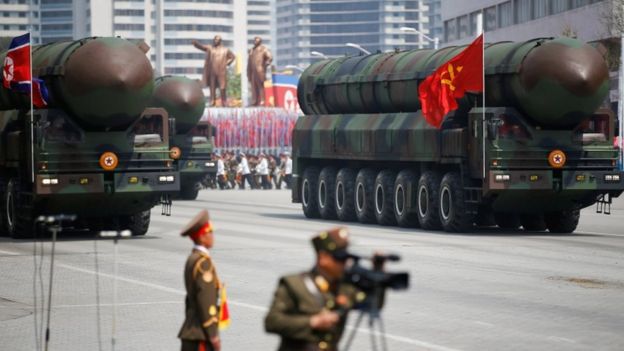 REUTERS
REUTERSIn September 2016, North Korea launched a volley of three ballistic missiles. In March 2017, they launched four more. The simultaneous launch of several missiles means tracking and intercepting them is harder, and that also poses a challenge to Thaad, the controversial new ballistic missile defence system being deployed in South Korea.
So does North Korea have a long range missile?
The question that seems to fascinate Americans the most is whether North Korea can deploy a missile to reach US shores.
The main reason to have an ICBM is for a nuclear strike. There is little point in putting a conventional weapon on such a missile.
North Korea has paraded ICBMs since 2012, when they revealed not only a missile known as the KN-08, but an illicitly-procured Chinese truck as a TEL. The missiles were initially criticised as "fakes" but over time, improvements made them credible. The latest parade appeared to show two different solid fuel ICBMs in addition to a dramatically altered KN-08.
Outsiders have dismissed North Korea's ability for decades but should probably pay attention to a few key developments.
In 2015, North Korea responded by introducing an ICBM known as the KN-14. In 2016, its propaganda featured images and video of essentially all the components one would need for an ICBM.

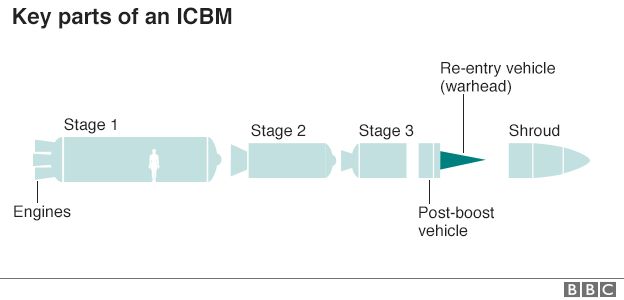
First, North Korea released photos of Kim Jong-un standing between a KN-08 ICBM and a purported nuclear warhead that would fit in it. Second, North Korea simulated a heat shield test for a re-entry vehicle the same month - a key stage that distinguishes a space launch vehicle from an ICBM.
An ICBM leaves the Earth's atmosphere like a space launch vehicle but must return a warhead back through the atmosphere intact, so simulation helps make sure it can withstand the heat and pressure of re-entry.
In addition, North Korean engineers tested a remarkable re-engineering of the Soviet R-27 engine in order to double it and indications are that it has jumped to a more "energetic" fuel. That engine test in April 2016 showed a translucent pink-purple flame rather than the yellow flame analysts are used to seeing from Scud-based engines.
 REUTERS
REUTERSIf the flame colour does indicate more energetic fuel, then this ICBM puts not just Alaska and Hawaii at risk, but London and Washington DC too - by using a better fuel they can throw more weight farther.
So when will North Korea actually test an ICBM? The answer to that is, when it is good and ready to.
The two new solid fuel ICBMs seen on the parade are years away from testing. But high-level UK embassy defector Thae Yong-ho said Pyongyang aims to complete the development of one ICBM by the end of 2017 or early 2018. Testing and "completing" are two different things.
It seems likely North Korea will test the liquid fuelled KN-08 ICBM in this time frame since it is apparently closest to completion.
But it is also likely that it will fail multiple times before it can be deployed.
Melissa Hanham is a Senior Research Associate in the James Martin Center for Nonproliferation Studies at the Middlebury Institute of International Studies in Monterey, California, USA.
Comments
Post a Comment